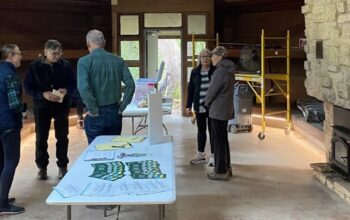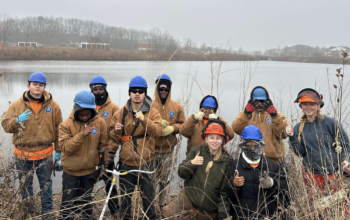In August 2018, Steve Schmitt lost between $50,000 and $70,000 in inventory when The Shoe Box, the store he owns in Black Earth, was flooded.
“I was covered with insurance for fires and theft and everything imaginable except flood insurance, because the premiums were way over my head in order to be covered for flood insurance,” Schmitt said. “Who would have ever thought in all those years that we’d have a flood to that level in Black Earth?”
Schmitt bought The Shoe Box in 1968 and continues to operate it today.
“I heard on the scanner that there was severe damage in Black Earth, Cross Plains and the west side of Madison. I got in my vehicle and I took off,” Schmitt said.

Three years and nearly $1 million dollars later, The Shoe Box was finally restored.
The 2018 flood hit Dane County hard. Community members, homes and local businesses were all impacted to varying degrees. A month after the floods, the county said 1,544 residences and 107 businesses experienced some form of damage related to the flood.
Repairing all of the buildings and homes damaged by the flood was not a timely or cheap process, but further repairs to restore the local landscape may help stop large flood events from causing as much damage in the future.
It is important for environmental restoration practices to account for future rain and flood events as the possibility of flooding has increased over time, according to Daniel Wright, an assistant professor of civil and environmental engineering at UW–Madison.
“In general, the trend is definitely a strong upwards one in terms of annual precipitation amounts,” Wright said.
The Watershed and Ecosystem Services division of the Dane County Land and Water Resources Department is currently working on a stream restoration project for Black Earth Creek.
Following the floods, the division toured the county’s held easements, land owned by one entity that is available for use by another entity or the public, located along waterways to determine if restoration was needed. It was. The division determined that by restoring these areas, it could not only create a healthier environment for the animals that live there and the people that visit it, but it could also help prevent flooding events in the future.
James Brodzeller is the current lakes and watershed program coordinator for Watershed and Ecosystem Services in the county. Though these floods happened several years ago, large stream or wetland projects take at least one to two years to move from the initial idea and concept to the physical construction, according to Brodzeller.
“The project probably won’t be started until at least late May or early June of next year [2024],” Brodzeller said.
The timeline constraints to begin the project are in place to avoid stream disturbance to fish such as smallmouth bass, that call the creek home and tend to spawn in the springtime.
However, Brodzeller and the other people working on this project are trying a different approach for the Black Earth Creek restoration. Common practice for stream restoration is to add rock to stabilize the banks and help lock the stream into place. The goal of this restoration project is to use trees and large logs to disperse water across a wider area, rather than bordering the creek with rock.
“A lot of ears and eyebrows get raised,” Bronzeller said. “We’re trying to do a bit more natural channel design and use natural solutions.”
The project is expected to restore roughly 4,000 linear feet of the creek, which starts in the downstream end of the Village of Mazomanie. The biggest impacts that Black Earth Creek suffered from in 2018 were erosion and shoreline instability. The goal is to fix these issues and create an environment that is more resistant to shoreline erosion.
“We want to try to slow the water down and spread it out across a larger area instead of sending it downstream where the flood damage and magnitude of flooding may actually increase,” Brodzeller said.
The Land and Water Resource Department is not the only group that has started to adapt and plan for future flood events. Despite the fact that floods are an environmental issue, flood mitigation techniques go beyond the environment.
“The basic issue is that stormwater infrastructure, the pipes and manholes meant to move the water, may not be large enough to move it downstream fast enough to drain an area,” Wright said.
According to Wright, the floods of 2018 pushed Madison to place more money, time and effort into more detailed maps of which areas in the city are more vulnerable to flood events. It may have taken time, but the flood damage will soon be nothing but a memory, especially as Dane County works hard to mitigate flood risks in the future.
“Put it in the hands of the people that know more than I do and take care of the streams and creeks and whatever else,” said Schmitt, owner of The Shoe Box. “My hat’s off to them for taking care of this.”






